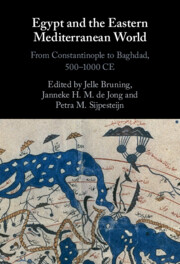Book contents
- Egypt and the Eastern Mediterranean World
- Egypt and the Eastern Mediterranean World
- Copyright page
- Contents
- Figures, Graphs, and Tables
- Notes on Contributors
- Notes on Transliteration, Names, and Dates
- Preface and Acknowledgments
- Additional material
- Introduction
- Part I Political and Administrative Connections
- Part II Economic Connections
- Part III Social and Cultural Connections
- Chapter 10 The Destruction of Alexandria: Religious Imagery and Local Identity in Early Islamic Egypt
- Chapter 11 Scribal Networks, Taxation, and the Role of Coptic in Marwanid Egypt
- Chapter 12 A Changing Position of Greek? Greek Papyri in the Documentary Culture of Early Islamic Egypt
- Chapter 13 Regional Diversity in the Use of Administrative Loanwords in Early Islamic Arabic Documentary Sources (632–800 CE): A Preliminary Survey
- Chapter 14 Babylon/Qaṣr al-Shamʿ: Continuity and Change at the Heart of the New Metropolis of Fusṭāṭ
- Chapter 15 Utilizing Non-Muslim Literary Sources for the Study of Egypt, 500–1000 CE
- Index
- References
Chapter 14 - Babylon/Qaṣr al-Shamʿ: Continuity and Change at the Heart of the New Metropolis of Fusṭāṭ
from Part III - Social and Cultural Connections
Published online by Cambridge University Press: 01 December 2022
- Egypt and the Eastern Mediterranean World
- Egypt and the Eastern Mediterranean World
- Copyright page
- Contents
- Figures, Graphs, and Tables
- Notes on Contributors
- Notes on Transliteration, Names, and Dates
- Preface and Acknowledgments
- Additional material
- Introduction
- Part I Political and Administrative Connections
- Part II Economic Connections
- Part III Social and Cultural Connections
- Chapter 10 The Destruction of Alexandria: Religious Imagery and Local Identity in Early Islamic Egypt
- Chapter 11 Scribal Networks, Taxation, and the Role of Coptic in Marwanid Egypt
- Chapter 12 A Changing Position of Greek? Greek Papyri in the Documentary Culture of Early Islamic Egypt
- Chapter 13 Regional Diversity in the Use of Administrative Loanwords in Early Islamic Arabic Documentary Sources (632–800 CE): A Preliminary Survey
- Chapter 14 Babylon/Qaṣr al-Shamʿ: Continuity and Change at the Heart of the New Metropolis of Fusṭāṭ
- Chapter 15 Utilizing Non-Muslim Literary Sources for the Study of Egypt, 500–1000 CE
- Index
- References
Summary
The Roman fortress of Babylon, Qaṣr al-Shamʿ or Qaṣr al-Rūm in medieval sources, and now known as Miṣr al-Qadīma or Old Cairo, is a logical place to begin in “setting the scene,” chronologically and topographically, for the foundation of the early Islamic miṣr of Fusṭāṭ. However, the fortress represents much more than merely an exotic historical backdrop to later events, and it is the aim of this chapter to explore some aspects of the central role it played in the foundation and subsequent development of Fusṭāṭ following the Muslim conquest of Egypt in 641 CE. In particular, we will argue that archaeological evidence for the original size of the fortress and the layout of its buildings and streets shows how these explicitly dictated the form of the centre-ville of Fusṭāṭ. The northern half of the fortress with its large, high-status buildings was integrated into the elite areas at the core of the new city, arranged around an administrative and ceremonial space created by the Friday mosque of ʿAmr b. al-ʿĀṣ and the governor’s residence. We will also demonstrate that much of the space for the central quarters of the new city was only made available by a major rerouting of the Red Sea Canal, and that archaeological evidence from the Church of Abū Sarga indicates the significant part played by the Christian population in the overall urban project.
- Type
- Chapter
- Information
- Egypt and the Eastern Mediterranean WorldFrom Constantinople to Baghdad, 500-1000 CE, pp. 446 - 464Publisher: Cambridge University PressPrint publication year: 2022



